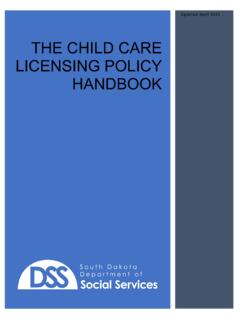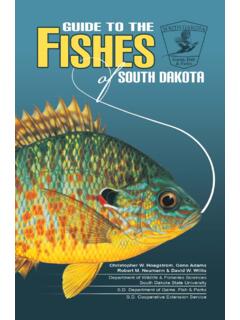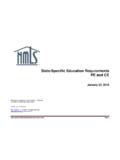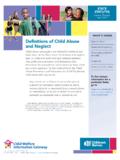Transcription of Guidelines - South Dakota
1 EARLY LEARNINGG uidelinesSouth DakotA3 The South Dakota Early Learning GuidelinesAcknowledgments ..4 Introduction ..6 Purpose of The Early Learning Guidelines ..6 Children s Success in School ..8 Working Together to Help Children Make Progress ..8 Guiding Principles ..9 About The Early Learning Guidelines ..10 Organization of this Document ..11 Goals and Developmental Indicators: Domains, Components, Developmental Continuums ..15 Approaches to Learning Domain ..15 Curiosity, Information-Seeking, and Eagerness ..17 Initiative, Effort, Engagement, and Persistence ..21 Risk-Taking, Problem-Solving, Flexibility, and Resiliency.
2 25 Play and Imagination ..29 Social and Emotional Development Domain ..33 Developing a Positive Sense of Self ..35 Developing Relationships ..39 Self-Regulation and Pro-Social Behaviors ..43 Communication, Language, and Literacy Communicating and Oral Language Development ..52 Foundations for Reading ..58 Foundations for Writing ..66 Learning New Languages ..70 Cognitive Development Domain ..73 Construction of Knowledge: Thinking and Reasoning ..76 Mathematical Thinking and Expression ..81 Scientific Exploration and Knowledge ..88 Social Studies, Family, and Community Connections ..94 Creative Arts and Expression ..99 Health and Physical Development Domain.
3 105 Physical Health and Growth ..107 Motor Development ..112 Self-Care, Safety, and Well-Being ..117 AppendicesAppendices ..123 Appendix A Supporting Children with Disabilities ..124 Appendix B Supporting Dual Language Learners ..126 Appendix C Frequently Asked Questions ..133 Appendix D Overview of Domains, Components and Goals 137 Helpful Terms ..141 Selected Sources ..146 Dedication ..148 The South Dakota Early Learning GuidelinesTable of Contents4 The South Dakota Early Learning GuidelinesACKNOWLEGEMENTSThis publication is dedicated to South Dakota s early childhood professionals, teachers, caregivers, parents and all of the adults who nurture and support the development of young children.
4 The South Dakota Early Learning Guidelines are adapted, with permission, from the North Carolina Foundations for Early Learning and Development. Additional resources consulted in the development of this document include the Head Start Early Learning Outcomes Framework (2015) and early learning and development Guidelines /standards documents from Alaska, Georgia, Iowa, NAEYC Saudi Arabia, North Dakota , Rhode Island, Vermont and South Dakota Early Learning Guidelines were developed by a panel of professionals and parents from the early childhood community throughout the state including: child care, Head Start, private and public preschool, kindergarten, special education, university early childhood programs, state agencies, and representatives from the South Dakota Association for the Education of Young Children (SDAEYC).
5 South Dakota EARLY LEARNING Guidelines CONTRIBUTORSSOUTH Dakota EARLY LEARNING GUIDELINE PROJECT COORDINATOR AND AUTHORDr. Gera Jacobs Professor of Early Childhood, USD. Past President, NAEYCSOUTH Dakota EARLY LEARNING Guidelines OVERSIGHT COMMITTEEK risti Swier, SD Department of Education, Head Start Collaboration Office Sarah Carter SD Department of Education, Birth to Three Program Diane Lowery, SD Head Start Training and Technical AssistancePat Monson SD Department of Social Services, Division of Child Care Services Melissa Fluckey SD Department of Social Services, Division of Child Care ServicesCarroll Forsch SD Department of Social Services.
6 Division of Child Care Services5 The South Dakota Early Learning GuidelinesSOUTH Dakota EARLY LEARNING Guidelines REVIEW PANEL MEMBERST eresa Berndt Steph LebedaKim Booth Vicki Linn, Bortnem, Regina McKenneySherrie Bosse Val PetersKaay Bowman, , Anne ReddyKay Cutler Kathy SchwartzMarcy Drew Kayla SerockiCindy Fisher Sarah Sherlock.
7 Grosz Carmen StewartLaura Johnson-Frame Connie StockdaleKristie Larson Rhonda Swanson Megan Larson, Wendy Trujillo The panel wishes to extend their appreciation to Susan Plaine and the South Dakota Department of Education, Division of Learning and Instruction for their assistance in completion of this edition of the South Dakota Early Learning Guidelines document. The panel wishes to extend special thanks to Catherine Scott-Little for consultation on this project.
8 Catherine is Associate Professor in the Department of Human Development and Family Studies at the University of North Carolina at Greensboro. She has completed several national studies on state-level early learning Guidelines , including content analyses on preschool and infant-toddler early learning standards from over 45 states. She has served as an advisor on early learning standards in numerous states. Catherine has also co-authored several publications on the topics of early learning standards. Dr. Scott-Little s expertise and continued guidance throughout the process has been greatly Recognition to Consultant Dr. Catherine Scott Little6 The South Dakota Early Learning GuidelinesPurpose of The South Dakota Early Learning GuidelinesChildren s experiences before they enter school matter.
9 Research shows that children who experience quality care and education are better prepared for school and throughout their lives. The Early Learning Guidelines (ELG) serve as a shared vision for young children. This document describes developmentally appropriate goals for children s development and learning at each age level: infant, toddler, and preschooler. These goals apply to all children regardless of what language they speak, what strengths or disabilities they may have, or their specific unique family circumstances. Strategies to enrich the environment, support development and learning, and adaptations provide a variety of ideas to goals outlined within the Early Learning Guidelines document for children can be used by teachers, home and center-based child care providers, Head Start staff, child care and school administrators, early childhood special educators, librarians and other professionals who support and promote children s development and learning.
10 It is, however, important to remember that while the ELG can help determine what is typical for children in an age group, what is written for a child s age may not always describe an individual child s development. If a child s development and learning does not seem to fit with what is included in ELG under his/her age level, look at the younger or older age group to see if there is a better fit for the child. The goal is to learn what developmental steps the child is taking now, and to meet the individual needs of that child on a daily basis. The Early Learning Guidelines can also be used as a resource for parents and other family members. Parents can use the Goals and Developmental Indicators to identify appropriate goals for their child to support learning and developing skills to support future success in addition, the Early Learning Guidelines are intended to be a guide for teaching.












